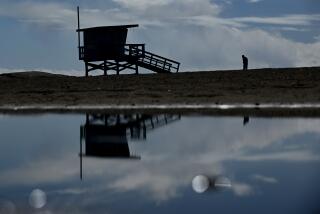2nd Major Break Found in Sewage Pipe : Pollution: Officials speculate that new rupture at 5,800 feet offshore may have been caused by a ship.
- Share via
Diving a mile offshore, underwater teams have discovered a second major break in the massive outfall pipe that for more than two weeks has sent as much as 180 million gallons a day of partially treated sewage spewing into the ocean, officials said Tuesday.
Divers discovered a “partial joint separation” about 5,800 feet from the rocky cliffs of Point Loma during an expedition late Sunday. They then noticed a “five-inch movement of joint at the top” of the pipe, which normally discharges the sewage flow 2.2 miles offshore.
For the first time, Deputy City Manager Roger Frauenfelder Tuesday said that when the Coast Guard first detected the spill on the afternoon of Feb. 2, crewmen reported a “boil in the sea,” about a mile offshore, just outside a wide line of fertile kelp beds.
“But then the next day,” Frauenfelder said, “we found the effect they described at 3,100 feet and thought we had a big problem at that location. We didn’t notice what was happening a mile out because, at that point, the entire stream of effluent was being discharged 3,100 feet from the shoreline,” at a depth of 35 feet.
Frauenfelder said Tuesday that divers had discovered large “scrapes” on the top of five sections of pipe, leading to speculation that a ship might have damaged the outfall structure. He conceded, however, that few large ships travel so close to shore.
“There was evidence of leakage at that point “ Frauenfelder said, referring to 5,800 feet offshore. “There was also evidence of physical damage. There were large scrape marks in the vicinity of the partial separation, and some of the large armor rock placed on the side had found its way underneath the pipe, causing it to sit in an arched position.”
City officials continue to maintain that “natural, external” forces damaged the pipe, each section of which is 25 feet long and weighs 30 tons. Investigators had detected damage in 500 feet of outfall pipe, but Tuesday the figure was extended to 750 feet.
Frauenfelder said the new break was discovered at a depth of 55 feet. Normally, the effluent is discharged at a depth of 220 feet, 11,000 feet from shore. Workers are continuing to inspect the rest of the pipe, and city officials conceded the possibility that more sections could be damaged.
Frauenfelder said he had asked the Coast Guard to “assist in reviewing every large ship that passed through the area” in the period leading up to Feb. 2.
“Large Navy ships don’t ordinarily operate that close to the kelp beds at such a shallow depth, but at this point we’re at a loss to explain what caused the scratch marks,” he said.
Asked if he believed a ship had scratched the pipe, Frauenfelder said, “Perhaps not a ship, but something being dragged by a surface craft. . . . We don’t want to speculate on the type of craft, but do want to take a good look at any possibility.”
Workers at the Point Loma plant, where most of the county’s sewage is treated and released into the pipe, told The Times last week that the combination of exercising a diversion gate and throttling valve had created a “water hammer” that may have triggered the rupture.
Officials have disputed that account, although the Regional Water Quality Control Board called for a full investigation of the spill’s cause, to be conducted by an “independent forensic expert” approved by the board.
In other developments, officials said crew members on the 100-foot-by-300-foot barge working to repair the pipe had:
* Placed offshore anchor rocks Sunday and completed placing inshore anchor rocks Monday to “stabilize undisturbed ends of pipe.” Crews have placed a total of 2,000 tons of rock, Frauenfelder said.
* Continued underwater inspections of the pipeline Sunday and Monday. Frauenfelder said divers were inspecting pipe as far away as 6,500 feet from the shore.
* Began lifting existing loose sections of the pipe and placing them on board the barge.
* Imported additional rock from Santa Catalina Island. Smaller pieces of rock are used underneath the pipe to act as a kind of cradle, with 1-ton chunks of ballast rock being used on the sides “to help withstand heavy currents and wave action,” Frauenfelder said.
* Began making plans to connect new sections of pipe with existing pieces that have been lifted from the ocean floor.
Frauenfelder said that, despite recent storm-caused delays, workers still hope to finish repairs by early April.
He said that bacterial counts in the ocean near the spill were down from Saturday and Sunday, but on Monday, readings 17 times the legal limit were recorded at the site of the spill, a mile north of Cabrillo National Monument.
He said readings 12 times the legal limit were recorded late Monday at Imperial Beach, which continues to be affected by a different spill--the daily discharge of 12 million gallons of raw sewage from Tijuana, mixing with contaminated rain-runoff from swollen creek beds and rivers.
Frauenfelder said that, a few miles north of the Point Loma spill, readings are now “quite low” and well beneath the legal limit, although county authorities continue to quarantine 20 miles of coastline, from the international border to the San Diego River, in the neighborhood of Ocean Beach.
More to Read
Sign up for Essential California
The most important California stories and recommendations in your inbox every morning.
You may occasionally receive promotional content from the Los Angeles Times.













